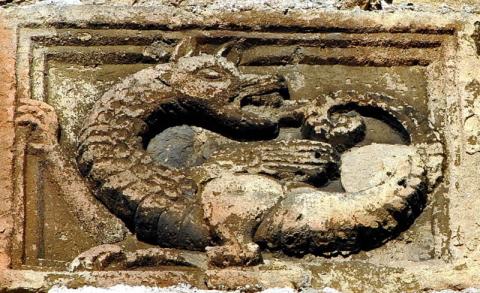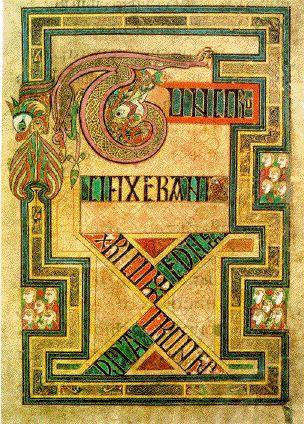[8] Frātrēs vērō coepērunt currere ad nāvim, dēprecantēs patrōcinium sānctī patris. Pater singulōs manibus trahēbat intus; [9] relictīs omnibus quae portābant in illam īnsulam, coepērunt nāvigāre. Porrō illa īnsula ferēbātur in ōceanum; immō poterant vidēre ignem ārdentem super duo mīliāria.
[10] Sānctus Brendānus nārrāvit frātribus quid hoc esset, dīcēns: “Frātrēs, admīrāminī quod fēcit haec īnsula?” [11] Aiunt: “Admīrāmur valdē, necnōn et ingēns pavor penetrāvit nōs.” [12] Quī dīxit illīs: “Fīliolī, nōlīte expavēscere: Deus enim revēlāvit mihi hāc nocte per vīsiōnem sacrāmentum huius reī. [13] Īnsula nōn est, ubi fuimus, sed piscis, prior omnium natantium in ōceanō. Quaerit semper suam caudam ut simul iungat capitī, et nōn potest, prae longitūdine. Quī habet nōmen Iascōnius.”
notes
Terrified, the monks rush back to the boat, and Brendan helps them in. They abandon the things they brought onto the island and sail off. Then the "island" moves away, though they can still see their fire burning. Brendan explains that he had known all along that the island was really the largest of sea creatures. He is always trying to bring his tail together with his head, but he is too long. His name is Iasconius.
[8] Pater singulōs manibus trahēbat intus: compare the way Jesus rescued Peter from drowning at Matthew 14.31: “And immediately Jesus stretching forth his hand took hold of him and said to him, "O thou of little faith, why didst thou doubt?” ("Et continuo Iesus extendens manum adprehendit eum et ait illi, ‘Modicae fidei, quare dubitasti?").
[9] relictīs omnibus quae portābant in illam īnsulam = omnibus quae portābant in illam īnsulam relictīs. (CL) would probably be portāverant. The things they left behind are still there a year later (15.17).
[10] quod fēcit: = (id) quod fēcit.
[12] hāc nocte per vīsiōnem: in a waking vision during the night, not in a dream; they spent the night in prayer (9.4).
[13] prior: ahead of all others, most important (OLD 7).
Quaerit semper suam caudam: the image has been connected with the ouroboros (“tail-eater”), a symbol for the renewal of life, originally from Egypt.
nōmen Iascōnius: The name is said to be from Irish iasc (“fish").
vocabulary
| dēprecor dēprecārī dēprecātus sum | to intercede with, entreat, beg [OLD 3] 8 |
| patrōcinium –ī n. | protection, patronage |
| intus | within, inside |
| nāvigō nāvigāre nāvigāvī nāvigātus | to go by ship, sail; to row 9 |
| porrō | next |
| ōceanus –ī m. | the ocean |
| immō | and in fact |
| mīliārium –(i)ī n. or mīliārius –(i)ī m. |
a thousand paces, a mile [OLD 1c] |
| admīror admirārī admirātus sum | to wonder at, marvel 10 |
| faciō facere fēcī factus | to do, make; to act, conduct oneself [OLD 28] |
| admīror admirārī admirātus sum | to wonder at, marvel 11 |
| valdē | powerfully; intensely, exceedingly |
| necnōn | and indeed, certainly |
| pavor pavōris m. | fear, trembling |
| penetrō penetrāre penetrāvī penetrātus | to penetrate |
| fīliolus –ī m. | little son, dear son 12 |
| ex-pavēscō –pavēscere –pāvī — | to become afraid |
| revēlō –āre | to unveil, uncover |
| per | through; by means of [OLD 14] |
| vīsiō –ōnis f. | vision, appearance of mystical, prophetic, or supernatural nature |
| sacrāmentum –ī n. | oath; mystery (ML) |
| piscis piscis m. | fish 13 |
| natō natāre natāvī natātus | to swim |
| ōceanus –ī m. | the ocean |
| cauda –ae f. | the tail, coda |
| prae | (prep. + abl.) in front of, in the face of (ML); by means of, because of, in view of |
| longitūdō longitūdinis f. | length |
| Iasconius –(i)ī m. | Iasconius |


